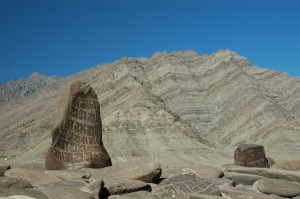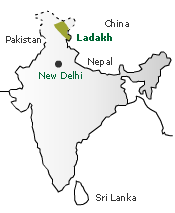
Ladakh is a region in north-westernmost India. It is truly a magical place. The dominant culture is Buddhist and some would say is the last stronghold of true Tibetan culture. Isolated from the oppressive Chinese government, the Ladakhi people have been able to find peace and solitude in the high Zanskar mountains. Ladakh is also a Mecca as it were for world-class geology. From paradigm shifting sedimentary sequences and complete ophiolite series to subduction magmatism and ultra-high pressure metamorphic rocks Ladakh has it all.
Our journey to Ladakh will traverse a cross section of a classic volcanic arc complex. Beginning with the Indus suture zone and the Ladakh oceanic arc proceeding through the Shyok suture zone and all its ophiolite goodness to the Karakorum continental arc. This transect covers nearly 100 million years of subduction magmatism and accretion and over 50 million years of continent-continent collision.
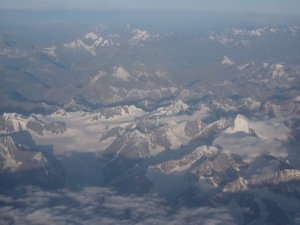 |
| Ladakh from the air |
The flight from New Delhi to Leh is absolutely incredible. To get the most out of this step, the flight must be done with no cloud cover so you can see the Himalaya in all its greatness and glory. Once you have arrived make your way to the
Whispering Willow Hotel in the town of Shey. The owner, Dorjay is a geologist and if you are lucky, Dorjay will show you around. If you are really lucky, His Holiness the Dalai Lama will be speaking in the local football pitch.
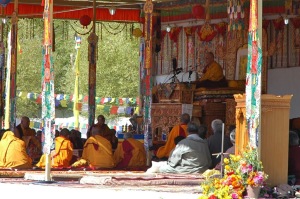 |
| His Holiness the Dalai Lama |
Our geologic transect begins with the Zanskar gorge. The Zanskar river cuts through the Indus suture zone which marks the collision zone between the Indian Plate and the Kohistan-Ladakh island arc. Lithologies vary significantly through this transect including ultramafic melange, submarine volcanics, cherts, and conglomerates. In my opinion, this is the best way to experience these rocks.
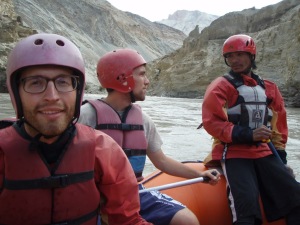 |
| Carl Hoiland (left), Joel Edwards (center), and guide rafting the Zanskar |
At the confluence of the Zanskar and Indus rivers we cross the Indus suture into the Indus Group. The Indus Group is a 2 km thick sequence of marine and terrestrial sedimentary rocks which were deposited in an evolving late-forearc and intermontane basin setting during the closure of Neo-Tethys and onset of Indo-Asia collision. The Indus Group has proven to be very important in nailing down the timing of the Indo-Asia collision. Traditionally defined, the collision between to continents begins when all marine sedimentation ceases and purely terrestrial sedimentation takes over. The Indus Group represents the first series of purely terrestrial sediments. However the unraveling of the original stratigraphy and structural relationships are made difficult by the superimposing deformation caused by the ever present Himalayan orogeny.
|
|
| Prayer stones with Indus formation in the background |
Outboard from the Indus Formation we have the Ladakh batholith which was emplaced during island arc magmatism as the oceanic crust attached to the northern margin of India subducted to the north beneath the last slice of the Neo-Tethys oceanic crust. The Ladakh batholith is characterised by coarse-grained granite and granodiorite with abundant diorite enclaves concentrated at the margins and nearly absent towards its core. In the core of the batholith, large potassium feldspar dominate the mineralogy. The main part of the Ladakh batholith comprises the Late Cretaceous-Eocene (102-50 Ma) granitoids which is bounded on its southern and northern margin by the Indus Group and the Shyok suture zone, respectively.
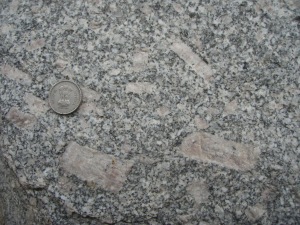 |
| K-feldspar in the core of the Ladakh batholith |
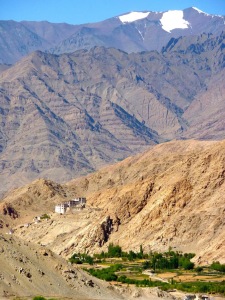 |
Ladakh batholith in the foreground with Buddhist monastery
and the Indus Group in the background |
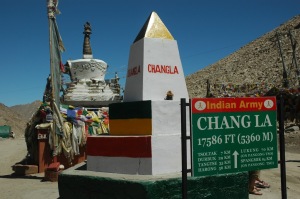 |
| 3rd highest motorable pass in the world |
Continuing north from the Ladakh island arc we first drove over Chang La — the third highest motorable pass in the world —to arrive at the Karakoram Fault. This near vertical fault has been traced for more than thousand kilometers cutting across the Indo-Asian suture. The timing of movement along this fault is constrained to post-18 Ma (as it cuts 18 Ma leucogranites in the Karakoram batholith) and is still be active today. Ar-Ar dating has further constrained the portion of the fault in Ladakh to have been activated at 13.9 Ma.
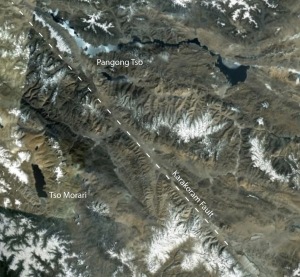
Across the Karakorum fault is the Shyok suture zone (my favorite part of the trip). The Shyok suture zone is a thick mélange considered by many to be a remnant of a Cretaceous back-arc basin separating the Ladakh island arc from the Karakoram continental arc and thus the Asian margin. The suture zone is primarily an ophiolite mélange, with mafic volcanics and minor amounts of sediments incorporated in the mix. Within the Shyok suture zone we find many of the classic parts of a supra-subduction ophiolite complex with exception of the sheeted dikes and layered gabbros. However, like many ophiolite complexes the lack of these components might imply either that they did not form as part of the oceanic lithosphere or that were removed during tectonic erosion during continued subduction and collision, which appears to be the case in the Shyok suture zone.
The first part of the mélange we encounter is a series of large (~200 to 400 meter) blocks of limestone surrounded by serpentinite matrix. These lozenges of limestone represent seamounts that formed in the back arc ocean and were scraped off and caught up in the mélange.
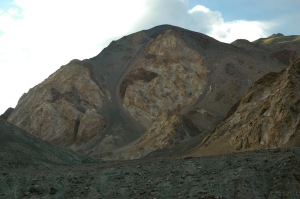 |
| Limestone lozenges in matrix of ultramafic and mafic melange |
Further down the road is an excellent exposure of pillow basalts which represent the top of the back-arc ocean crust. It is amazing that these pillows survived relatively intact despite all of the deformation and destructive processes taking place since their formation.
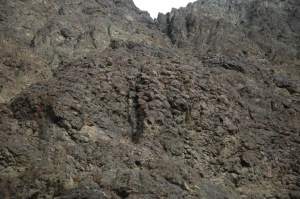 |
| Pillow basalts of the Shyok Ophiolite |
Lastly is a thick section of ultramafic rocks many of which have been altered to serpentinite.
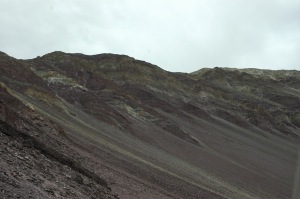 |
| Ultramafic hillside of peridotite and gabbro interlayered with green serpentinite and calcsilicates |
Adjacent to the Shyok ophiolite in the Tangtse gorge is the Pangong Metamorphic Sequence. The Pangong Metamorphic Complex is a 10 km wide band of a steeply dipping sequence of metapelites, psammites, metamarls and amphibolites. These metamorphic rocks – surprising to me – were not metamorphosed during the Indo-Asian collision nor by the accretion of the Ladakh arc. Rather these rocks were metamorphosed at 108 Ma during the subduction and magmatism associated with the Karakoram arc. These rocks were metamorphosed at ~600ºC at about 20-25 km.
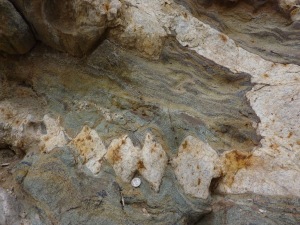 |
| Metamorphosed calc-silicate with deformed leucogranite sill |
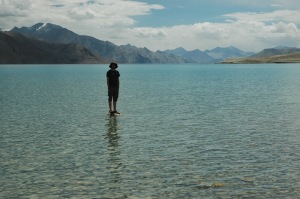 |
| Carl Hoiland at Pangong Tso on the Tibetan border |
Intruding the Pangong Metamorphic Sequence is a spectacular series of leucogranite dikes and sills. These leucogranites form a complex intrusive sheet network that are linked to large plutons that extend along the shear zone of the Karakoram fault towards the Karakoram Batholith. These leucogranites have dated at 20 to 14 Ma and are similar to the other Miocene leucogranite found throughout the Greater Himalayan Sequence further to the south. These leucogranites are unique in that they have hybrid compositions more akin to a mixture of mantle and crustal rocks. Whereas the Miocene leucogranites of the High Himalaya have extremely evolved crustal signatures. For whatever reason the leucogranite further to the north were able to mix more with rocks of a mantle signature.
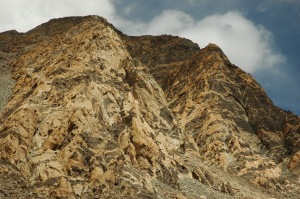 |
| Miocene leucogranite intrusions in calc-silicate rocks |
Unfortunately we were unable to make it to the Karakoram batholith although it could be seen in the distant peaks off to the north. Like the Ladakh batholith, the Karakoram batholith was formed during the northward subduction of first the Ladakh island arc which was followed by the Indian plate.
If we are to keep with the somewhat chronologic fashion of the story, we now must jump back out south of the Indus suture zones to the gneiss dome of Tso Morari. Within the center of the dome Precambrian basement gneisses are exposed with eclogite boudinage interspersed throughout the basement rocks. The Tso Morari eclogites are remarkable for the depths at which they equilibrated. These ultra-high-pressure lozenges contain coesite (a high-pressure form of quartz) and micro-diamond form inclusions within garnet. These key minerals indicate that these eclogite blocks were metamorphosed at temperature greater than 700°C at nearly 100 km deep. It is interesting to think of the speed at which these rocks must have rocketed to the surface in order to preserve these rare mineral assemblages.
 This work is licensed under a Creative Commons Attribution-NonCommercial-ShareAlike 4.0 International License.
This work is licensed under a Creative Commons Attribution-NonCommercial-ShareAlike 4.0 International License.








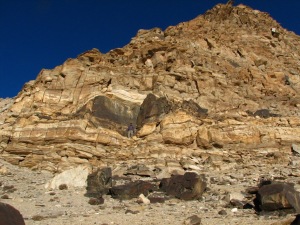
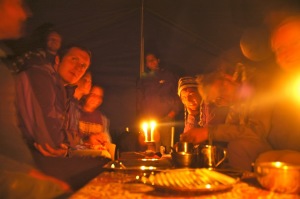
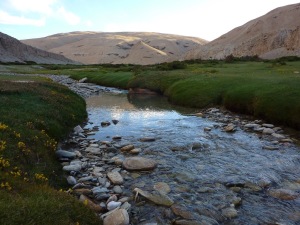
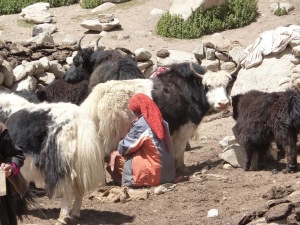
![]() This work is licensed under a Creative Commons Attribution-NonCommercial-ShareAlike 4.0 International License.
This work is licensed under a Creative Commons Attribution-NonCommercial-ShareAlike 4.0 International License.


